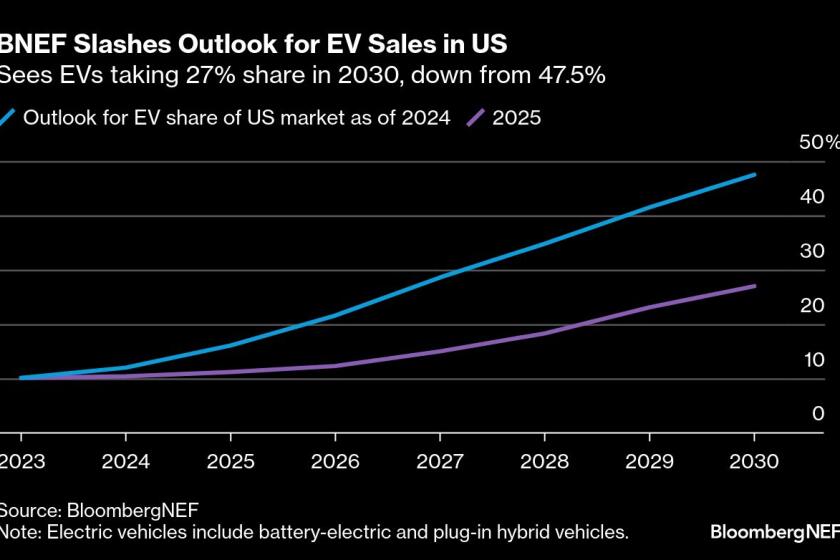Factory Sale : Van Nuys Faces Tough Road in Finding a Buyer for GM Plant
- Share via
During their recent campaigns for city offices, few candidates passed up the opportunity to make grand pronouncements about how they would restore the 2,600 jobs lost when General Motors closed its auto assembly plant in Van Nuys last August. A few even used the shuttered factory as a dramatic backdrop when announcing their candidacies.
But as GM quietly gears up efforts to sell the huge plant and the 100-acre parcel on which it sits, many business and real estate experts believe that the site may become one of the biggest industrial real estate white elephants Los Angeles has seen.
“I can’t be optimistic,” said Michael Beltramo, a Santa Monica-based management consultant. “I see that plant sitting there for a number of years.”
The odds are stacked against a successful transformation of the property anytime soon. For one thing, the cleanup of paints, solvents and gasoline undoubtedly left after 45 years of auto manufacturing could take years and millions of dollars to complete.
The chances of any auto maker moving to Van Nuys are virtually nil, despite state officials’ much-publicized effort to get Mercedes-Benz to put its new American plant there. The few auto makers adding new facilities want lower-cost states and proximity to their suppliers in the Midwest and Southeast.
The possibility of luring another type of manufacturer to the 71,000-square-foot Van Nuys plant is also unlikely because many manufacturers are downsizing or moving out of state. What’s more, the experiences of other Southern California communities in recovering after losing auto plants in the 1970s and ‘80s support the view that Van Nuys has a tough road ahead.
City of Commerce still has not completely recovered from the closure of a Chrysler plant there more than 20 years ago. That 100-acre site was purchased in 1972 by Dallas developer Trammell Crow, which tore down part of the auto plant and built smaller industrial and office buildings. Now the redeveloped area employs about 2,500 workers in a record-manufacturing facility, a grocery distribution plant and small offices--about half the number of workers at the Chrysler plant at its peak.
Since the plant closed, Commerce has also been hit by the closure of plants owned by U.S. Steel, Firestone Tire & Rubber and Uniroyal. Trammell Crow developed the latter into the successful Citadel retail outlet mall.
But Ira Gwin, Commerce’s director of community development, said: “We’ve lost a lot of our good-paying, blue-collar workers, and they’ve been replaced by quite a bit of office, retail and low-paying, non-union warehouse workers.”
Even so, Commerce probably had an easier time with its redevelopment than Van Nuys will because the permitting process today is so cumbersome and real estate financing is hard to find.
*
Widely viewed as the biggest obstacle to redeveloping the Van Nuys site is California’s inhospitable business climate. Without an active government helping smooth the way for a new owner, “10 years from now, you’re still going to be 10 years away from anything happening there,” said James Schriner, principal of PHH Fantus, a New York consulting firm that advises manufacturers on selecting sites.
Schriner, who recently helped BMW choose South Carolina for its first U.S. assembly plant, said other communities offer manufacturers tax breaks, financing assistance and new facilities. They invest in studies and marketing efforts. “California typically has not done that,” he said.
In fact, only after pleading by GM did the Los Angeles City Council recently shelve a proposal to rezone the Van Nuys property for more restrictive uses. GM argued that the rezoning would impede its efforts to sell the site.
GM listed the plant with commercial real estate broker Cushman & Wakefield last month, but there are “no strong leads” on possible buyers, GM spokeswoman Janine Fruehan said.
Fruehan said GM has met with a task force formed by the City Council to help with the plant’s conversion. But there have been no specific offers of government assistance, she said.
Los Angeles Planning Director Con Howe promised a cooperative approach by his department in efforts to find another use for the plant.
“In the past, the city’s attitude has been: It’s private property, it’s a private problem,” Howe said. “The first hurdle is for the city to accept that it does have a role to play. At a minimum, we should not put up inappropriate barriers.”
Many politicians have floated ideas for other uses of the Van Nuys plant. Most focus on the notion of creating a public-private partnership to foster new transportation technologies--similar to the Calstart consortium for the development of an electric car industry. The group moved into an abandoned Lockheed Corp. building in Burbank.
City Fire Capt. Lyle Hall, for instance, pledged to work to reopen the GM plant as an electric car factory.
Hall is headed for a June runoff with former mayoral aide Richard Alarcon for the City Council seat representing the area that includes the Van Nuys plant.
*
Assemblyman Richard Katz, a former mayoral candidate, has a plan to help turn the plant into a center for the development of advanced transportation projects.
Some professionals see other potential uses for the site.
Mike Howard, senior vice president at commercial and industrial real estate broker Grubb & Ellis in Sherman Oaks, believes that government agencies such as the South Coast Air Quality Management District, which is looking for space, could move in and become the genesis for a service-oriented complex that would eventually include engineering, architectural and transportation firms.
Others see possibilities for retail development. Pat Hall, president of TOLD Partners Inc., a real estate brokerage in Woodland Hills, said a large retail complex or retail distribution center is among the few uses he finds plausible at Van Nuys in the near future, although he added that the run-down condition of the neighborhood could prove a deterrent.







